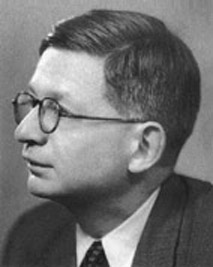Rudolph Peierls: Difference between revisions
No edit summary |
No edit summary |
||
| (14 intermediate revisions by 4 users not shown) | |||
| Line 1: | Line 1: | ||
== | {{Biography | ||
|Image=Rudolf-peierls-1.jpg | |||
|Birthdate=1907/06/05 | |||
|Birthplace=Berlin, Germany | |||
|Death date=1995/09/19 | |||
|Associated organizations=Birmingham University | |||
|Fields of study=Nuclear physics | |||
}} | |||
Rudolf Ernst Peierls was born on June 5, 1907, in Berlin, Germany. The son of a Jewish businessman, he studied nuclear physics under the tutelage of Werner Heisenberg and Wolfgang Pauli. His early work on quantum physics led to his development of the theory of positive carriers in 1929, which explained the thermal and electrical conductivity behaviors of [[Semiconductors|semiconductors]]. | |||
[[ | Peierls moved to Birmingham, England, when Adolf Hitler came to power in Germany. There, he found work teaching physics at Birmingham University, and in 1939, he started working on atomic research with Otto Frisch and [[James Chadwick]]. In 1940, Peierls and Frisch wrote a paper that explained how a [[Nuclear Bombs|uranium fission bomb]] could become a weapon that could win World War II. The three-page paper estimated that the energy released in a nuclear chain reaction and how one could devise an atomic bomb from a small amount of fissable uranium-235. This paper sparked the interest of British and American authorities, which would eventually lead to the [[Manhattan Project|Manhattan Project]]. | ||
Peierls joined the Manhattan Project in 1943 as part of "The British Mission," being placed in charge of a small group concerned with evaluating the chain reaction and its efficiency. He had been excluded from joining in the early years because of his German origin. | |||
Peierls | After the war, Peierls resumed his position as professor of physics at Birmingham University, where he worked until 1963 before joining the University of Oxford. He was knighted in 1968, and he retired from Oxford in 1974. He died in Oxford on September 19, 1995. | ||
== Larson Collection Interview == | |||
{{#widget:YouTube16x9|id=cwmpJjNIbOs}} | |||
{{DEFAULTSORT:Peierls}} | |||
[[Category: | [[Category:Nuclear physics]] | ||
Latest revision as of 19:01, 25 February 2016
- Birthdate
- 1907/06/05
- Birthplace
- Berlin, Germany
- Death date
- 1995/09/19
- Associated organizations
- Birmingham University
- Fields of study
- Nuclear physics
Biography
Rudolf Ernst Peierls was born on June 5, 1907, in Berlin, Germany. The son of a Jewish businessman, he studied nuclear physics under the tutelage of Werner Heisenberg and Wolfgang Pauli. His early work on quantum physics led to his development of the theory of positive carriers in 1929, which explained the thermal and electrical conductivity behaviors of semiconductors.
Peierls moved to Birmingham, England, when Adolf Hitler came to power in Germany. There, he found work teaching physics at Birmingham University, and in 1939, he started working on atomic research with Otto Frisch and James Chadwick. In 1940, Peierls and Frisch wrote a paper that explained how a uranium fission bomb could become a weapon that could win World War II. The three-page paper estimated that the energy released in a nuclear chain reaction and how one could devise an atomic bomb from a small amount of fissable uranium-235. This paper sparked the interest of British and American authorities, which would eventually lead to the Manhattan Project.
Peierls joined the Manhattan Project in 1943 as part of "The British Mission," being placed in charge of a small group concerned with evaluating the chain reaction and its efficiency. He had been excluded from joining in the early years because of his German origin.
After the war, Peierls resumed his position as professor of physics at Birmingham University, where he worked until 1963 before joining the University of Oxford. He was knighted in 1968, and he retired from Oxford in 1974. He died in Oxford on September 19, 1995.
